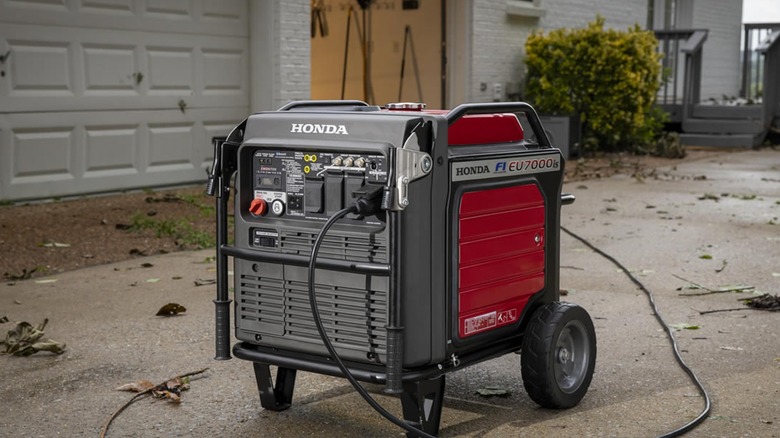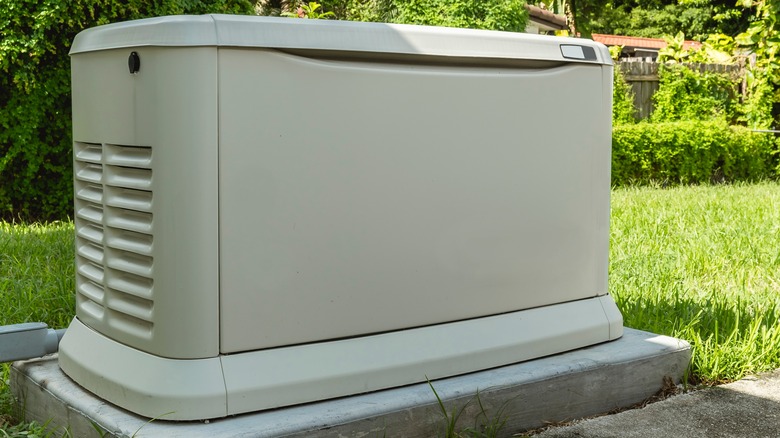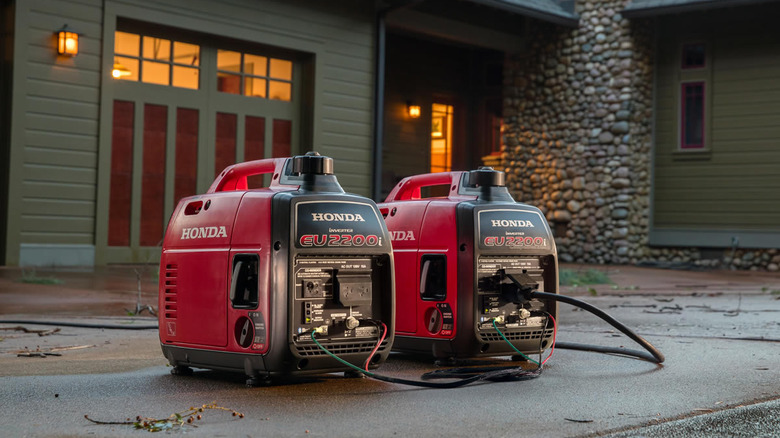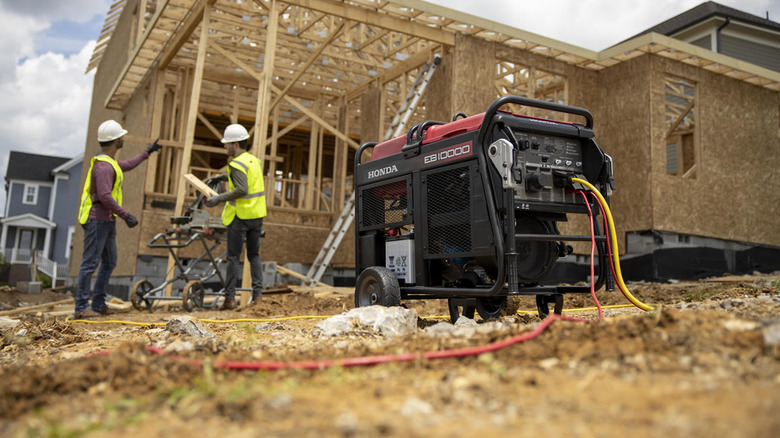Everything You Need To Know Before Installing A Honda Generator At Home
In addition to its many automotive products, the Honda brand also dabbles in a variety of other mechanically-minded sectors. These sectors include air travel, sea travel, and, of course, home care equipment like lawnmowers and generators. If you're looking to get a generator for your home, you could certainly do much worse than Honda for your branding. Even if the generators aren't what it's known for primarily, Honda has actually staked quite a claim for itself in the power scene amongst the likes of Craftsman and DeWalt.
Of course, as with any home generator setup, Honda-branded or otherwise, it's of the utmost importance that you do the proper research and preparations before you purchase one for your home. The last thing you want is to go to the trouble of spending all that money and hauling the thing home only for it not to work, or worse, cause some kind of damage to your home. All you need to do is take a moment to consider a few model and installation options, as well as ensure you've got all of the safety regulations down pat, and your new Honda generator will be up and running in no time.
The differences between portable and home standby generators
When you hear the word generator, what's the first thing that springs to mind? Probably a portable generator; something you can pick up and carry around, use to power either your home or a camper van? These are the kinds of generators that Honda specializes in, though that's not the only kind of generator there is. There are also home standby generators.
So which one is right for you? That depends mostly on your wants and needs. A portable generator is small and light enough that you pick it up and put it where you need it. They don't require any particular installation process; you just plug them in, put some fuel in, and push the button to get the power flowing. Of course, since they're smaller, a portable generator may not be able to generate enough juice to power everything in your home.
A home standby generator, on the other hand, is less of a tool and more of a utility. Home standby generators need to be professionally installed and wired into your home power grid, and once they're installed, they can't be easily moved. That big beast can provide a much greater degree of power, though — enough to light up most, if not all, of the house. As an added bonus, home standby generators are also plugged directly into your home's fuel system, so you don't need to manually fill it up to use it. Unfortunately, Honda doesn't sell this kind of generator, so it can't help you if this is the kind you want.
Extension cords versus transfer switches
In addition to the precise model of Honda generator you want to use, you'll need to consider how your selected generator will actually deliver power to your home. For this part, there are two primary options: extension cords and transfer switches.
An extension cord is, well, an extension cord. You've probably got one in your closet or garage somewhere. You plug one end of the cord into one of your generator's built-in outlets and the other end into your device or appliance of choice to deliver power. It's quick, cheap, and simple, making it good for situations where you only need to power a couple of simple things. However, using an extension cord to deliver power means you can only power a limited number of devices. Additionally, an extension cord cannot be used to power anything that's been hard-wired into your home's power grid, such as a water heater or furnace.
The other, more elaborate option is a transfer switch. In the same vein as a home standby generator, a transfer switch requires a professional installation by an electrician. A transfer switch allows you to immediately flip your home's power system off the public grid and onto a connected generator, which in turn allows you to circulate the power throughout your home without using individual hard connections. Not only does this allow you to power hard-wired appliances, but you can also directly control the flow of power in the same way you'd use a fuse box. Honda actually sells its own smart transfer switch called a UTS, which can deliver power around your home based on your needs.
Proper generator placement is vital
No matter what kind of generator you're using and how it's set up, one of the most vital points of installation is exactly where you put the thing. Whether you have a movable portable generator or a hard-wired home standby, all generators need to be placed in an outdoor, well-ventilated area.
The reason for this is the ever-present risk of carbon monoxide poisoning. Remember, generators are like small engines, and the fuel combustion process produces a steady stream of poisonous carbon monoxide. If the generator is in a well-ventilated, outdoor area a fair distance from your home, the CO will disperse safely into the air away from anyone who might accidentally breathe it. If you try to place a generator in an enclosed space, however, the CO can start to accumulate and fill the room. Anyone who enters a CO-filled room can swiftly become sick and faint and even die.
The nice thing about Honda's portable generators specifically is that they're equipped with CO-detection features. These features, collectively known as CO-MINDER, passively monitor the presence of CO in the generator's immediate vicinity. If an overabundance of CO is detected, the generator will immediately shut itself off and refuse to power back on until the gas is safely ventilated. It's a good feature to have in a pinch, but it's no substitute for proper placement and CO-management.
Take all safety measures into account before starting the generator
While the placement of a new generator and management of its carbon monoxide production are the most pressing safety concerns, they're definitely not the only ones. Before you install a Honda generator, you should be aware of all possible safety hazards and be ready to address them as necessary.
The other most important concerns below CO are electrocution and fire risks. In the former case, a generator should never be operated in wet conditions like rain or snow, and it should not be placed near large bodies of water like a swimming pool. A wet generator puts you at risk of electrocution, so keep it dry. Additionally, make sure all generator wiring is firm and fully plugged in. An improperly wired generator can cause an electrical current feedback to local electrical utilities, which is both unsafe in general and hazardous to utility workers.
As far as fire risks go, any kind of generator can become exceptionally hot while in operation, particularly in the vicinity of its external muffler. Make sure there are no flammable items or materials in the generator's vicinity before powering up and that it's at least three feet away from the side of your house. If the generator runs out of fuel, wait until it has cooled down enough to touch before you attempt to refuel it, as a stray spark could cause the gasoline to ignite while you're pouring it.



